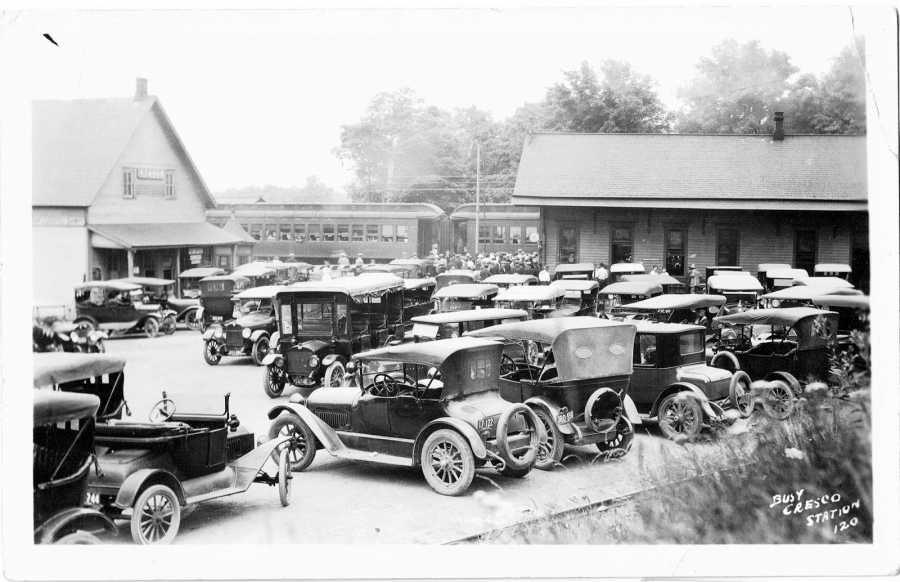The Cresco Post Office stood close by and Barrett’s main thoroughfare ran directly through the station property for additional action. The sharp turn in the track visible from the east side of the station was the site of a violent train wreck in 1903; a wreck that tempted two boys to walk from Mountainhome to Cresco to inspect the wreckage and approach a tarp. Two boys, too curious.
But in the 70’s the place stood deserted as the train tracks creaked only with the sun’s heat.
The line, originally laid in 1857 when the Delaware, Lackawanna & Western Railroad ran a line from Scranton, Pennsylvania, to Hoboken, New Jersey, was for freight, hauling the likes of coal, lumber, and leather, but without provision for passengers. Cresco made do with a pile of railroad ties covered with tarp to receive goods at that time. Only months after the track was laid, the economic downturn and ensuing panic of 1857 curtailed the need for shipments. The resourceful DL&W Railroad recognized a want for people to escape congested cities, and so began passenger service to points east of New York into Pennsylvania, augmenting a boom of inns and hotels that dotted the Pocono Mountain map. Barrett Township alone hosted upwards of seventy-five places to lodge, and droves of those lodgers arrived by rail at the Cresco Station.
Construction of the station proper began in the 1870’s, and after three years to complete stood ready in 1880 to pick up and deposit passengers. Painted a deep green with maroon trim in the typical Delaware Lackawanna style, the station’s upper windows were of stained glass, with Victorian embellishments and gingerbread dressing out the truss ends and gables. Facing trackside, the building had a three bay window area, protected from baggage cars by iron bars, where the station master viewed trains and tracks both east and west. The crossing gates at the road were hand operated.
The interior was simplicity itself, consisting of a baggage room, the station and ticket masters’ room, and a waiting room.
It wasn’t long before sheds were built to shelter the horses used for transportation. (The station predated automobiles.) Later, in the 1920’s, a canopy, which soon had to be doubled in size, was built for the autos and busses used to transport passengers to places with names like Onawa Lodge and Monomonock Inn.
In the 1880’s, railroading established standard time zones across the United States and implemented safety modernizations like air brakes. It was a time of improved passenger comforts, with the introduction of in-car heating and open ended observation platforms. And the Pullman Company began manufacturing dining cars; the DL&W dining service menu included Welsh rarebit, shad roe with bacon, pickled lamb tongue, and Heinz euchred pickles.
Through the 1890’s, the rail was used in main for payloads: ice, railroad ties, hides, sprags (coal mining car brakes manufactured by Theo B. Price in Cresco.) Trout eggs from the Paradise Trout Hatchery shipped all over the U.S. from Cresco.
Railroads were a major asset to a small community like Barrett. The Cresco spur, a mile of track radiating from the main line, delivered freight into the town. Materials for building Skytop Lodge arrived by rail; entire house kits purchased from Sears and Roebuck made their way along the spur. Late 1920’s deliveries of light lines for Pennsylvania Power and Light came back to the station in the form of electricity. But by the 1970’s, the last freight car to use the spur got stranded behind Theo B. Price Lumber and needed to be rescued by crane. The track was subsequently torn out.
The 1930’s and the war years belonged to the railroads, and Cresco station reached its heyday in the 1940’s during WWII, when gasoline and rubber rationing made car travel difficult. People weary of war flocked to the Poconos for escape. The Cresco Station had three business windows at that time: a ticket window and a Pullman coach window, and Western Union had a man dedicated to telegrams. A telegram received in the office read: “Send the overcoat I left there to L J Laugan Hotel Columbia Scranton by express today. DeKay.”
President Eisenhower’s post-war highway plan ushered in an automobile culture that allowed travel with more freedom than the railroads could provide, and railroad passenger use plummeted during the 1950’s, even as some American railroad companies tried to stem the tide with new equipment and promotional advertising for passengers that rarely came, although some riders still enjoyed the amenities offered. “In the late 1950’s we would take the train from Cresco into Hoboken, then the subway into New York,” says Warren “Mickey” Miller of Cresco. “We’d be tourists in the city, go to a show and shop. Then we would take the Phoebe Snow back and have dinner on the train. It was very elegant with beautiful silver and china. Dinner on the train was always special.”
But by the 1960’s passenger service was left for dead, and railroading went into spiraling decline as trucking ate away at its freight business. The Cresco Railroad Station closed in 1968 with the arrival of one final passenger train.
In 1970, Karl Weiler, of Weiler Abrasives, leased the station building from Conrail to use for storage. “At that time we began to maintain it,” says Weiler, “replacing rotted flooring and putting on a new roof.” He negotiated a $1-per-year lease in consideration for his efforts. Weiler also used it for a time as a brush outlet.
In the 1980’s the thought of using the building as a museum occurred to Weiler, and the Weiler Family Foundation eventually purchased the property from then owner Monroe County Rail Authority. But in the summer of 1989, vandals took a leisurely two weeks to destroy the station interior before the damage was discovered and reported. The blackguards smashed stained glass windows, solid oak doors, antique light fixtures emblazoned with the station masters insignia, and other irreplaceable antiques. The boys were discovered and charged, but their bestial gaiety still stings the community thirty years later. The event disappointed Weiler in the extreme, and he boarded up the building.
The vandalism, to some extent, became a catalyst for Weiler to begin restoration of the station. In the 1990’s he got to work, hiring builder Clark Bartholomew to lead construction. “It was a big project,” says Weiler. Bartholomew had special router bits made to shape replacement woods with historical correctness. Using photographs Bartholomew reproduced the car and bus canopy once used by area hotels.
After completion of renovations, Weiler turned the station keys over to Jacqueline Magann, chair of the Barrett Township Historical Society, to open it as a museum. “We wondered, ‘how do we fill this building!’” says Mrs. Magann. But as word got out about the project, people began to bring items, and now the building could pass for Barrett’s attic. It is chockablock full of artifacts from the township, many of which date back more than a century. The permanent display of the Patriotic Order Sons of America has an excellent example of folk art, and the baggage room has been set up as a country store but includes a barberchair from Skytop Lodge and a dog sled from Buck Hill Inn. Civil War muskets are on permanent display, as is the electric scoreboard from the Barrett High School gymnasium.
Some pieces original to the station remain: large photographs of the Pocono landscape, a placard advertising round-trip tickets to Niagara Falls for $5. The telegraph ticker still holds its original place in the stationmaster’s room.
On a recent Sunday afternoon, an excursion train from Scranton’s Steamtown arrived late at the Cresco station as a freight train first assumed the track’s right-of-way. The freight made its halting pass by the station and around the sharp bend in the track, the site of earlier train wrecks, the turn where it is still rumored train cars lie submerged in the adjoining bog. The place where two curious boys walked down the track to see a wreck, and lifted a tarp to see what lay underneath. It was the wreck where the engineer, the fireman, and a passenger were killed.
Passengers from the Steamtown excursion detrained with smiles to inspect the old Cresco Station restored, to look at her exhibits, listen to fiddle music, grab a hot dog …to bring life to the place.


















